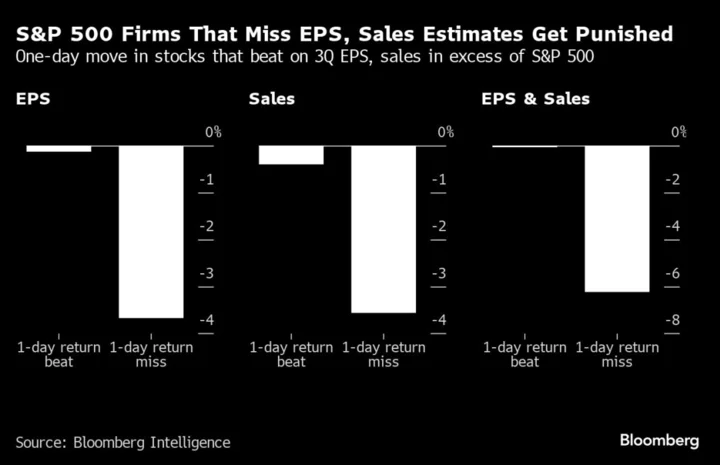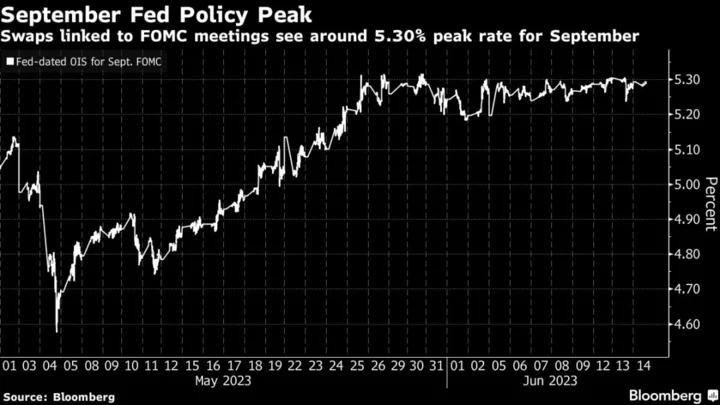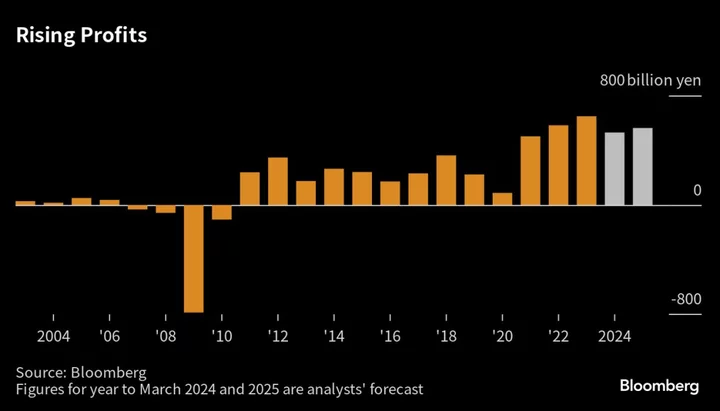Earnings season typically is the time when investors can look past macroeconomic forces and focus on company-specific news moving stocks. This quarter, however, is turning out to be anything but typical.
Individual shares have, of course, reacted to earnings announcements in the week or so since Corporate America started reporting results. But conflict in the Middle East and surging Treasury yields are taking precedence, causing S&P 500 Index constituents to increasingly move in unison as global events sway markets broadly.
In four of the six trading sessions since the reporting cycle kicked off on Oct. 13, at least 400 members in the S&P 500 have moved in the same direction. It’s a frequency that didn’t appear once in comparable weeks the past three earnings periods.
Such concerted moves — up and down — are further complicating the lives of stock pickers in a year when they’ve had little luck, with only 37% of large-cap active managers outperforming their benchmarks as of the end of September, data compiled by Bank of America Corp. show.
“Macro is dominating the narrative again,” Quincy Krosby, chief global strategist at LPL Financial, said by phone. “The situation in the Middle East obviously weighs on sentiment.”
Combined with 10-year yields near the highest since 2007 and the threat of a US government shutdown next month, “together, that’s making the lives of active stock pickers harder.”
Third-quarter earnings season is off to a mixed start. Most banks are doing fine, but Tesla Inc., one of the biggest gainers in the S&P 500 this year, disappointed.
Discerning winners from losers, at least in the immediate aftermath of corporate results, has been challenging: For example, 92% of the S&P 500 members rose Monday, and three other days since Oct. 13 saw at least 82% of shares moving in the same direction.
Investors are looking to earnings next week from a slew of Big Tech giants for signs of whether Wall Street projections are too optimistic since the market has been punishing results that fall short of expectations.
All told, companies in the S&P 500 that have beat projections on earnings per share and sales have underperformed the benchmark by an average of 0.1% within a day of reporting, well below the norm of the past six years, data compiled by Bloomberg Intelligence show. Meanwhile, those that fell short trailed by 6.2%, the biggest negative reaction in a year.
This may be a signal that company-focused bad news may not have been entirely priced into particular stocks. But it also suggests that the direction of US equities is being dictated more by macro-driven factors of late, given the relatively muted upside reaction to earnings beats.
The all-or-nothing days, a feature of the stock-market rout in 2022, have become more pronounced since the breakout of war in the Mideast, but they’ve been staging a comeback since mid-September.
With headwinds building, from the prospect of additional Federal Reserve interest-rate increases to the power vacuum in the US House of Representatives, it’s easy to see why measures of co-movements are on the rise again after hitting a multi-year low in July.
That’s not quite typical for earnings season, when stocks tend to dance to the tune of company-specific news as investors react to earnings scorecards. The days ahead — when the biggest tech firms are set to release results — will likely revert back to the typical pattern, said Citigroup Inc.’s Stuart Kaiser.
He points to positive Wall Street revisions to profit outlooks for the firms such as Apple Inc. and Microsoft Corp. over the past month as a sign of strong fundamentals in the group despite the worrisome global backdrop.
“While macro concerns related to higher Treasury yields persist, we believe the focus on company-level fundamentals will take center stage in the near-term, driving down realized correlations,” said Kaiser, Citigroup’s head of US equity trading strategy.









